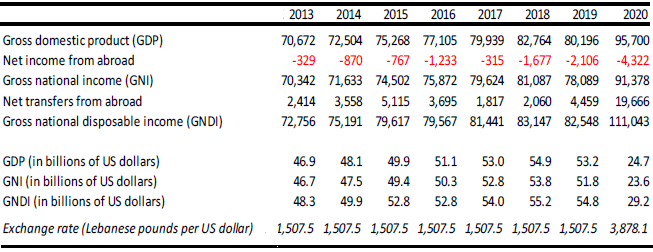In an editorial in Annhar Newspaper published on 9/9/2022 titled “Economists and Their Mistakes”, the article reprimands Lebanese economists – a bit belligerently — for citing Gross National Income (GNI) in Lebanon, apparently for 2021, to be around $22 billion instead of what the article purports to be $47 billion. Though Lebanese economists are not immune from mistakes – who is, really! – the article, perhaps in an act of “poetic justice”, seems to have committed three mistakes itself: 1) the reference to the $22 billion that economists rightly cite is for Gross Domestic Product (GDP) not GNI, as the article claims; 2) GDP and GNI are two different income concepts and values and should not be confused with each other, as the article seems to have done; 3) the relevant income measure that the article mistakenly calculates is not for GNI but actually is for Gross National Disposable Income (GNDI).
To clarify matters, we are not going to do anything fancy; we are just going to present the definitions and values for these income variables as provided by the Central Administration of Statistics (CAS) in its Lebanese National Accounts 2020. They are as follows:
1) GDP is equal to the value-added in the production of goods and services in the domestic economy. It is also equal to the sum of final consumption expenditures (households and government), gross fixed capital formation (private and public), and net exports (Exports minus Imports) of goods and services.
2) GNI is a more specific concept of income, since it adds to the value of GDP the primary incomes receivable from non-resident units, while deducts the primary incomes payable to non-resident units: GNI = GDP + NI (Net Income)
3) GNDI is equal to GNI less current transfers (remittances and other transfers) payable to non-resident units, plus the corresponding transfers receivable by resident units from the rest of the world. Gross National Disposable Income measures the income available to the total economy for final consumption and gross saving: GNDI = GDP + NI + NT (Net Transfers).
So basically, GDP measures the income generated domestically; GNI is GDP plus net income received from abroad; and GNDI is GNI plus net transfers from abroad. The latter two concepts measure the additions to domestic income that is supported from abroad. CAS has data for these variables starting from 2013 till 2020. As the table below shows, throughout that period GDP was higher than GNI because net income was negative (but the difference was small), but GNDI was higher than both because of the large positive net transfers (primarily remittances). The largest difference between GDP and GNDI was in 2020, GDP being at $24.7 billion and GNDI at $29.2 billion. And the reason is twofold: GDP has fallen considerably because of the financial and economic crisis; and net transfers (both personal such as remittances and official such as grants and donations) have risen notably to around $5.1 billion.
So we can conclude the following: a GDP of $22 billion for Lebanon in 2021 sounds very reasonable; GDP and GNDI measure two different things: GDP measures income generated domestically while GNDI measures income generated and received by the domestic economy; and given that GDP was around $22 billion in 2021, there was no way that GNDI reached $47 billion!

In the table above, the first set of numbers in the top rows are in Billions Lebanese Pounds.